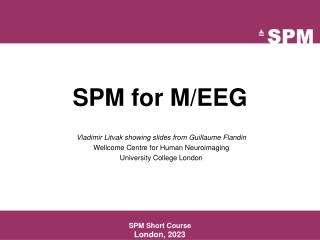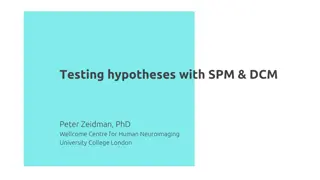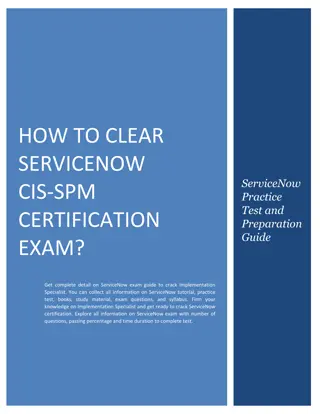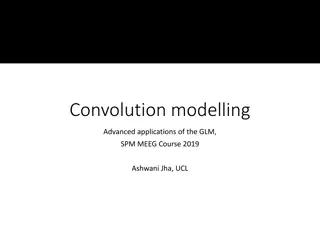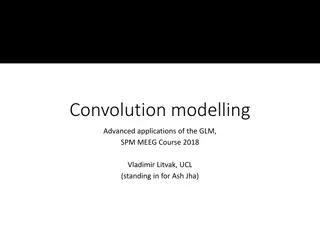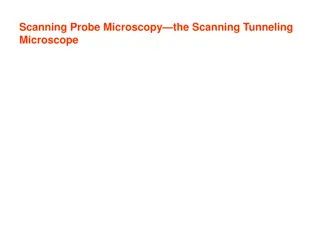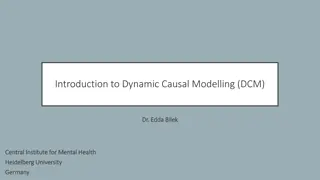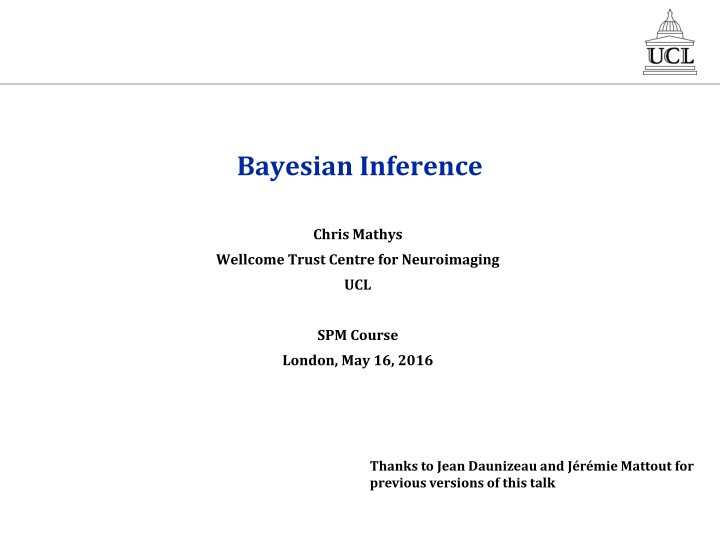
Bayesian Inference: Logical Probability in Science
Explore Bayesian inference and its relevance in answering uncertain scientific questions, such as the relationship between chocolate consumption and winning the Nobel Prize. Discover how probabilistic reasoning is intertwined with logic, deriving from fundamental principles set by scholars like R. T. Cox and James Clerk Maxwell. Probability theory, the essence of common-sense calculation, unfolds as a powerful tool in scientific investigation.
Download Presentation

Please find below an Image/Link to download the presentation.
The content on the website is provided AS IS for your information and personal use only. It may not be sold, licensed, or shared on other websites without obtaining consent from the author. If you encounter any issues during the download, it is possible that the publisher has removed the file from their server.
You are allowed to download the files provided on this website for personal or commercial use, subject to the condition that they are used lawfully. All files are the property of their respective owners.
The content on the website is provided AS IS for your information and personal use only. It may not be sold, licensed, or shared on other websites without obtaining consent from the author.
E N D
Presentation Transcript
Bayesian Inference Chris Mathys Wellcome Trust Centre for Neuroimaging UCL SPM Course London, May 16, 2016 Thanks to Jean Daunizeau and J r mie Mattout for previous versions of this talk
A spectacular piece of information May 16, 2016 2
A spectacular piece of information Messerli, F. H. (2012). Chocolate Consumption, Cognitive Function, and Nobel Laureates. New England Journal of Medicine, 367(16), 1562 1564. May 16, 2016 3
So will I win the Nobel prize if I eat lots of chocolate? This is a question referring to uncertain quantities. Like almost all scientific questions, it cannot be answered by deductive logic. Nonetheless, quantitative answerscan be given but they can only be given in terms of probabilities. Our question here can be rephrased in terms of a conditional probability: ? ????? ???? ?? ? ??????? = ? To answer it, we have to learn to calculate such quantities. The tool for this is Bayesian inference. May 16, 2016 4
Bayesian = logical and logical = probabilistic The actual science of logic is conversant at present only with things either certain, impossible, or entirely doubtful, none of which (fortunately) we have to reason on. Therefore the true logic for this world is the calculus of probabilities, which takes account of the magnitude of the probability which is, or ought to be, in a reasonable man's mind. James Clerk Maxwell, 1850 May 16, 2016 5
Bayesian = logical and logical = probabilistic But in what sense is probabilistic reasoning (i.e., reasoning about uncertain quantities according to the rules of probability theory) logical ? R. T. Cox showed in 1946 that the rules of probability theory can be derived from three basic desiderata: 1. Representation of degrees of plausibility by real numbers 2. Qualitative correspondencewith common sense (in a well-definedsense) 3. Consistency May 16, 2016 6
The rules of probability By mathematical proof (i.e., by deductive reasoning) the three desiderata as set out by Cox imply the rules of probability (i.e., the rules of inductive reasoning). This means that anyone who accepts the desiderata mustaccept the following rules: 1. (Normalization) ?? ? = 1 2. (Marginalization also called the sum rule) ? ? = ?? ?,? 3. (Conditioning also called the product rule) ? ?,? = ? ? ? ? ? = ? ? ? ? ? Probability theory is nothing but common sense reduced to calculation. Pierre-Simon Laplace, 1819 May 16, 2016 7
Conditional probabilities The probability of ? given ?is denoted by ? ? ? . In general, this is different from the probability of ? alone (the marginal probability of ?), as we can see by applying the sum and product rules: ? ? = ? ?,? = ? ? ? ? ? ? ? Because of the product rule, we also have the following rule (Bayes theorem) for going from ? ? ? to ? ? ? : ? ? ? =? ? ? ? ? ? ? ? ? ? ? ? ? ? ? ? = ? ? May 16, 2016 8
The chocolate example In our example, it is immediately clear that ? ????? ? ??????? is very different from ? ? ??????? ????? . While the first is hopeless to determine directly, the second is much easier to find out: ask Nobel laureates how much chocolate they eat. Once we know that, we can use Bayes theorem: model likelihood prior ? ????? ? ??????? =? ? ??????? ????? ? ????? ? ? ??????? posterior evidence Inference on the quantities of interest in fMRI/DCM studies has exactly the same general structure. May 16, 2016 9
Inference in SPM forward problem ? ? ?,? likelihood posterior distribution ? ? ?,? inverse problem May 16, 2016 10
Inference in SPM Likelihood: ? ? ?,? ? ? ? Prior: ? ? ?,? =? ? ?,? ? ? ? Bayes theorem: ? ? ? generative model ? May 16, 2016 11
A simple example of Bayesian inference (adapted from Jaynes (1976)) Two manufacturers, A and B, deliver the same kind of components that turn out to have the following lifetimes (in hours): B: A: Assuming prices are comparable, from which manufacturer would you buy? May 16, 2016 12
A simple example of Bayesian inference How do we compare such samples? May 16, 2016 13
A simple example of Bayesian inference What next? May 16, 2016 14
A simple example of Bayesian inference The procedure in brief: Determine your question of interest ( What is the probability that...? ) Specify your model (likelihood and prior) Calculate the full posterior using Bayes theorem [Pass to the uninformative limit in the parametersof your prior] Integrate out any nuisance parameters Ask your question of interest of the posterior All you need is the rules of probability theory. (Ok, sometimes you ll encounter a nasty integral but that s a technical difficulty, not a conceptual one). May 16, 2016 15
A simple example of Bayesian inference The question: What is the probability that the components from manufacturer B have a longer lifetime than those from manufacturerA? More specifically: given how much more expensive they are, how much longer do I require the components from B to live. Example of a decision rule: if the components from B live 3 hours longer than those from A with a probability of at least 80%, I will choose those from B. May 16, 2016 16
A simple example of Bayesian inference The model (bear with me, this will turn out to be simple): likelihood (Gaussian): 1 2 ? ? exp ? 2?? ?2 ? ?? ?,? = 2? ?=1 prior (Gaussian-gamma): ? ?,? ?0,?0?0,?0 = ? ? ?0, ?0? 1Gam ? ?0,?0 May 16, 2016 17
A simple example of Bayesian inference The posterior (Gaussian-gamma): = ? ? ??, ??? 1Gam ? ??,?? ? ?,? ?? Parameterupdates: ? ??= ?0+? ??= ?0+ ? ?0, ??= ?0+ ?, ?0+ ? 2 ??= ?0+? ?0 ?2+ 2 ? ?0 2 ?0+ ? with ? ? ? 1 ?2 1 ?? ?2 ? ?=1 ??, ? ?=1 May 16, 2016 18
A simple example of Bayesian inference The limit for which the prior becomes uninformative: For ?0= 0, ?0= 0, ?0= 0, the updates reduce to: ??=? ??=? 2?2 ??= ? ??= ? 2 As promised, this is really simple: all you need is ?, the number of datapoints; ?, theirmean; and ??, theirvariance. This means that only the data influence the posterior and all influence from the parameters of the prior has been eliminated. The uninformative limit should only ever be taken after the calculation of the posterior using a proper prior. May 16, 2016 19
A simple example of Bayesian inference Integrating out the nuisance parameter ? gives rise to a t- distribution: May 16, 2016 20
A simple example of Bayesian inference The joint posterior ? ??,?? ?? ?, ?? ? is simply the product of our two independent posteriors and ? ?? ?? ? ? ?? ?? ?. It will now give us the answer to our question: ? ?? ??> 3 = d??? ?? ?? ? d??? ?? ?? ? = 0.9501 ??+3 Note that the t-test told us that there was no significant difference even though there is a >95% probability that the parts from B will last at least 3 hours longer than those from A. May 16, 2016 21
Bayesian inference The procedure in brief: Determine your question of interest ( What is the probability that...? ) Specify your model (likelihood and prior) Calculate the full posterior using Bayes theorem [Pass to the uninformative limit in the parametersof your prior] Integrate out any nuisance parameters Ask your question of interest of the posterior All you need is the rules of probability theory. May 16, 2016 22
Frequentist (or: orthodox, classical) versus Bayesian inference: hypothesis testing Classical Bayesian define the null, e.g.: invert model (obtain posterior pdf) ?0:? = 0 ? ? ?0 ? ? ? ? ?0? ? ? > ? ?0 ? ? ? ? ? ?0 define the null, e.g.: estimate parameters (obtain test stat.) ?0:? > ?0 apply decision rule, i.e.: apply decision rule, i.e.: ? ? > ? ?0 ? then reject H0 if if then accept H0 ? ?0? ? May 16, 2016 23
Model comparison: general principles Principle of parsimony: plurality should not be assumed without necessity Automatically enforced by Bayesian model comparison Model evidence: y = f(x) ? ? ? = ? ? ?,? ? ? ? d? exp ???????? ?????????? Occam s razor : x model evidencep(y|m) y=f(x) space of all data sets May 16, 2016 24
Model comparison: negative variational free energy F ??? ????? ???????? log ? ? ? = log ? ?,? ? d? sum rule ? ?,? ? ? ? = log ? ? d? a lower bound on the log-model evidence multiply by 1 =? ? ? ? log? ?,? ? ? ? d? ? ? Jensen s inequality =:? = ???????? ??????????? ???? ?????? ? ? ? log? ?,? ? d? ? ? Kullback-Leibler divergence = ? ? log? ? ?,? ? ? ? d? ? ? product rule = ? ? log? ? ?,? d? ?? ? ? ,? ? ? ?????????? ???????? (???????? ??? ??????????) May 16, 2016 25
Model comparison: F in relation to Bayes factors, AIC, BIC ????? ?????? ? ? ?1 = exp log? ? ?1 = exp log? ? ?1 log? ? ?0 Bayes factor ? ? ?0 ? ? ?0 Prior odds Posterior odds exp ?1 ?0 [Meaning of the Bayes factor: ? ?1? ? ? ?1 ? ? ?0 ? ?1 ? ?0] ? ?0?= ? = ? ? log? ? ?,? d? ?? ? ? ,? ? ? = Accuracy Complexity Number of parameters ??? Accuracy ? Number of data points ??? Accuracy ? 2log? May 16, 2016 26
A note on informative priors Any model consists of two parts: likelihood and prior. The choice of likelihood requires as much justification as the choice of prior because it is just as subjective as that of the prior. The data never speak for themselves. They only acquire meaning when seen through the lens of a model. However, this does not mean that all is subjective because models differ in their validity. In this light, the widespread concern that informative priors might bias results (while the form of the likelihood is taken as a matter of course requiring no justification) is misplaced. Informative priors are an important tool and their use can be justified by establishing the validity (face, construct, and predictive) of the resulting model as well as by model comparison. May 16, 2016 27
Applications of Bayesian inference May 16, 2016 28
posterior probability posterior probability maps (PPMs) maps (PPMs) segmentation segmentation and normalisation and normalisation dynamic causal dynamic causal modelling modelling multivariate multivariate decoding decoding realignment smoothing general linear model Gaussian field theory statistical inference normalisation p <0.05 template May 16, 2016 29
Segmentation (mixture of Gaussians-model) class variances 2 k 1 1 ith voxel label ci 2 yi ith voxel value class frequencies k class means grey matter white matter CSF May 16, 2016 30
fMRI time series analysis PPM: regions best explained by short-term memory model short-term memory design matrix (X) prior variance of GLM coeff prior variance of data noise AR coeff (correlated noise) GLM coeff PPM: regions best explained by long-term memory model long-term memory design matrix (X) fMRI time series May 16, 2016 31
Dynamic causal modeling (DCM) m1 m2 m3 m4 attention attention attention attention PPC PPC PPC PPC PPC PPC PPC PPC stim stim stim stim V1 V1 V1 V1 V1 V1 V1 V1 V5 V5 V5 V5 V5 V5 V5 V5 attention models marginal likelihood ln p y m ( estimated 0.10 0.10 ) effective synaptic strengths for best model (m4) 15 PPC PPC 0.39 0.39 0.26 0.26 10 1.25 1.25 0.26 0.26 stim V1 V1 0.13 0.13 V5 V5 5 0.46 0.46 0 m1 m2 m3 m4 May 16, 2016 32
Model comparison for group studies ( ) ( ) ln ln p y m p y m 1 2 m1 differences in log- model evidences m2 subjects Assume all subjects correspond to the same model Fixed effect Random effect Assume different subjects might correspond to different models May 16, 2016 33
Thanks May 16, 2016 34

